List of manned spacecraft
This is a list of Human spaceflight types, including space stations, sorted by nation and series in chronological order. Canceled programs are listed at the end.
Comparison
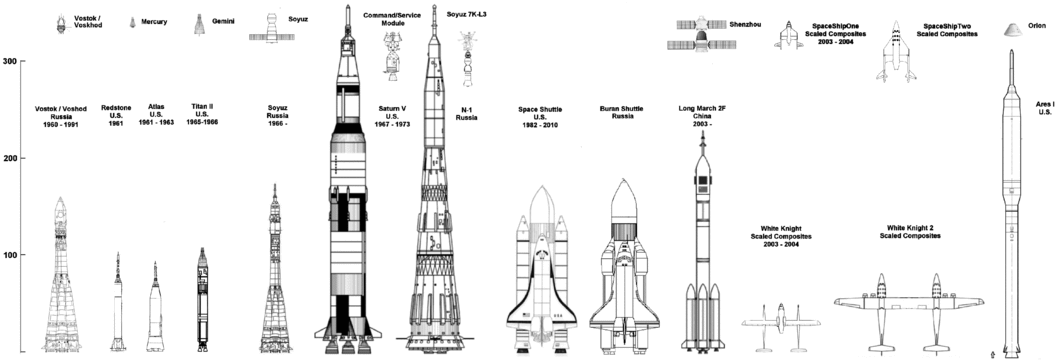
Scaled comparison of manned spacecraft, including names, manufacturers, and dates of operation
Current human spacecraft
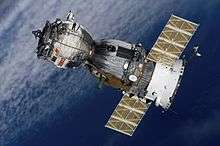
Soyuz-TMA spacecraft
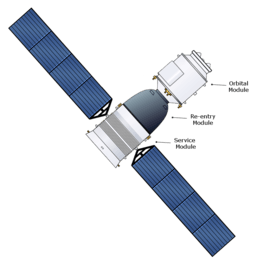
Shenzhou spacecraft
Orbital
Russian
- Soyuz (1967–present) 2 or 3 person Earth orbital;[1] fourth and fifth generations continued operation by Russian Federation
Chinese
- Shenzhou (2003–present) 3 person Earth orbital craft
Space stations
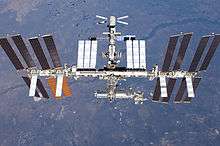
International Space Station
Main article: Space station
- International Space Station (1998–present)
- Tiangong 1 (2011–present)
Former human spacecraft
Orbital
Soviet/Russian
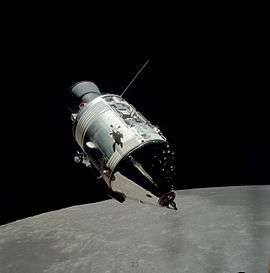
Apollo 17 spacecraft
- Vostok (1961–1963) single-person Earth orbital craft[2]
- Voskhod (1964–1965) 2 or 3 person Vostok derivative[3]
American
- Mercury spacecraft (1961–1963) single-person Earth orbital craft[4]
- Gemini spacecraft (1965–1966) 2 person Earth orbital craft[5]
- Apollo spacecraft
- Command/Service Module (1968–1975) 3 person Earth and lunar orbital craft[6]
- Lunar Module (1969–1972) 2 person lunar lander[7]
- Space Shuttle (1981–2011) 2 to 8 person Earth orbital craft; first orbit-capable spaceplane; first partially reusable spacecraft
Space stations
- Salyut series (1971–1991)[8]
- Skylab (1973–1974)
- Almaz series (1973–1977) Military reconnaissance stations, disguised as Salyut 2, 3 and 5
- Mir (1986–2001)
Suborbital
- X-15 (1959–1970) air-launched spaceplane; first X-15 flight to pass Kármán line occurred in 1963[9]
- SpaceShipOne (2003–2004) air-launched spaceplane
In development
Orbital
.jpg)
Orion ground test article
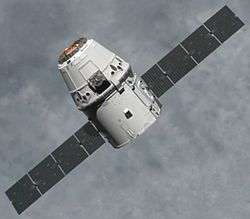
Dragon spacecraft during an uncrewed cargo mission to the ISS
Russian
- Federatsiya (Prospective Piloted Transport System) 4 person Earth orbital craft
American
- NASA's Orion 4 person beyond Earth orbit craft[10]
- SpaceX's Crew Dragon 7 person Earth orbital craft (operational cargo version being upgraded to carry crew)[11]
- Sierra Nevada's Dream Chaser 7 person Earth orbital space plane[11]
- Boeing's CST-100 Starliner 7 person Earth orbital craft[11][12]
- Blue Origin's orbital spacecraft[11]
- Excalibur Almaz commercial spacecraft
Indian
Iranian
British
- Skylon unpiloted reusable space plane with possible Passenger Module (engine in development)
Suborbital

SpaceShipTwo with mothership in hangar
Russian
American
- The Spaceship Company's SpaceShipTwo
- XCOR Aerospace's Lynx
- Blue Origin's New Shepard
- Masten Space Systems' XA Series
Romanian
Danish
French
- VSH manned version of VEHRA
British
- Starchaser Industries' Nova 2
- Starchaser Industries' Thunderbird
- Starchaser Industries' Thunderstar
Proposed
American
- Golden Spike Company's Flyer (lunar)
European
- Advanced Re-entry Vehicle (ARV) 4 person spacecraft (orbital)[13]
- ESA's Crew Space Transportation System (orbital)
- Mars One's Transit Living Module and Human Lander (Marsian)
Japanese
- JAXA's HTV-R (orbital)
American
- The Spaceship Company's SpaceShipThree (suborbital)
- Masten Space Systems' O Series (orbital)
- Masten Space Systems' XL Series (orbital/lunar)
Canadian
- DreamSpace Group's XF1 (suborbital)[14]
Cancelled
National Aeronautics and Space Administration (NASA)
- Space Transportation System (1976 - 2011, all elements canceled, except the Space Shuttle, which took the name)
- VentureStar, Lockheed Martin X-33 demonstrator (canceled 2001) single-stage-to-orbit (SSTO) shuttle
- Altair Lunar Surface Access Module for Constellation program
Joint NASA / United States Air Force
- Boeing X-20 Dyna-Soar (canceled 1963) winged orbital space plane, launched by Titan 3
- Manned Orbiting Laboratory + Gemini-B spacecraft (canceled 1969)
- Rockwell X-30 or National AeroSpace Plane (canceled 1993) to be used as a hypersonic transport plane or as a single-stage-to-orbit (SSTO) shuttle
Joint NASA / European Space Agency (ESA)
- X-38 (canceled 1999) lifting body crew-rescue vehicle for ISS
Soviet space program
- Soyuz 7K-VI Zvezda[15] (1962-1968; military researching ship)
- Soyuz 7K-L1 (1967–1970) part of the abandoned Soviet manned lunar flyby program
- Soyuz L3 spacecraft (late 1960s to early 1970s); part of the abandoned Soviet manned lunar landing program (The LOK would carry two cosmonauts into orbit around the Moon, acting as "mother" spacecraft for the LK Lander, which would land one member of the crew to the surface)
- Soyuz 7K-L3 (LOK) 2 person lunar orbital craft
- LK Lander Module single-pilot lunar lander
- Spiral-EPOS (also known as EPOS – Russian acronym for Experimental Passenger Orbital Aircraft – canceled 1976)[16]
- Shuttle Buran (1976-1988) canceled after one unmanned orbital flight[17]
- Strelec (Archer; 1979 - 1991) universal military 3 person spaceship - tank, which was created within the project of cosmical complex Sapfir (Sapphire, project canceled)[18]
- Zarya (project canceled 1989)
- MAKS (project canceled 1991)
Russian Federal Space Agency (RKA)
- Kliper (government funding canceled 2006)
European Space Agency (ESA)
Space stations
- Columbus-MTFF (project cancelled 1991)
China National Space Administration (CNSA)
UK
Japan
National Space Development Agency of Japan (NASDA)
Main article: National Space Development Agency of Japan
Other Japan
- Kankoh-maru (proposed)
Notes
- ↑ Gatland, pp.148-165
- ↑ Gatland, pp.109-115
- ↑ Gatland, pp.131-113
- ↑ Gatland, pp.148, 151-165
- ↑ Gatland, pp.166-185, 266-275
- ↑ Gatland, pp.190, 278-280
- ↑ Gatland, pp.191, 207, 283, 284
- ↑ Gatland, pp.229-246
- ↑ Long, Tony (2007-07-19). "July 19, 1963: Cracking the 100-Kilometer-High Barrier ... in a Plane". Advance Publications. Retrieved 18 November 2011.
- ↑ "Orion Quick Facts" (PDF). NASA. Retrieved 25 January 2016.
- 1 2 3 4 Ferster, Warren (2011-04-18). "NASA Announces CCDev 2 Awards". Imaginova Corp. Retrieved 18 November 2011.
- ↑
- ↑ "printer friendly page ATV evolution: Advanced Reentry Vehicle (ARV)". European Space Agency. 2010-03-25. Retrieved 18 November 2011.
- ↑ "Canadian space flight dreams live on". CBC News.
- ↑
- ↑
- ↑
- ↑
References
- Gatland, Kenneth (1976). Manned Spacecraft (2nd ed.). New York City: MacMillan Publishing Co., Inc. ISBN 0-02-542820-9.
| ||||||||||||||
| ||||||||||||||||||||||||||||||||||||||||||||||||||||||||||||||||
This article is issued from Wikipedia - version of the Tuesday, January 26, 2016. The text is available under the Creative Commons Attribution/Share Alike but additional terms may apply for the media files.